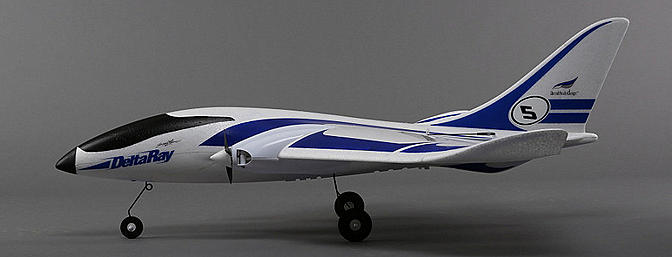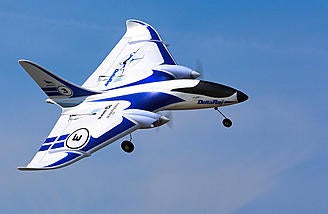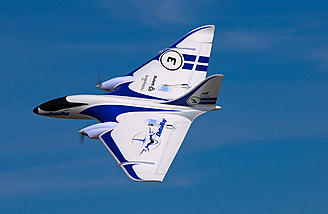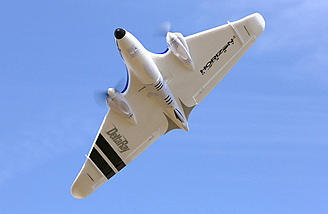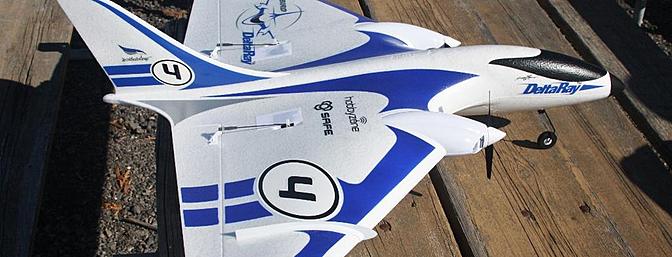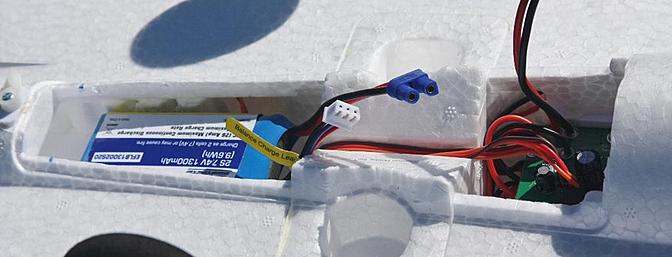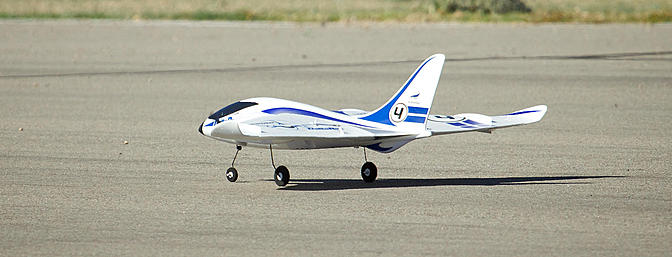Horizon Hobby & HobbyZone's Delta Ray RTF with Safe Technology Review
Horizon Hobby & HobbyZone's Delta Ray RTF with Safe Technology Review

Click Here:Delta Ray Promotional Video
Introduction

|
|
| Wingspan: | 34" |
| Flying Weight: | 17.6 oz. |
| Length: | 31.8" |
| Servos: | (2) SV80 installed |
| Transmitter: | Spectrum DX4e (included) |
| Receiver: | Spectrum on the control board |
| Battery: | 7.4V 2S 1300mAh 20C LiPo |
| Charger: | 2-cell DC balancing LiPo Charger (included) |
| Motor: | 2 x 180-size brushed motors installed |
| Propeller: | 2 x (5 x 3) |
| Experience Level: | Beginner on up |
| Manufacturer: | HobbyZone |
| Available From: | Horizon Hobby |
| Price: | $179.99 RTF |
| Price: | $149.99 BNF |
It is true! This plane has four flight modes! Beginner, Intermediate, Expert and one they call Panic. But It is so much more useful than just in panic situations I call it Autopilot. Keeping it simple Beginner, intermediate and expert modes all vary in the degree of rate they allow the controls to move. Beginner is the most limited so there is a limited angle to the right stick induced dive and climb as well as left and right. The Delta Ray is elevon controlled so there are only two servos, one per side and the safe technology simply limits the amount of throw to those controls. The intermediate mode has more movement and as they describe it enough movement for normal flight but not enough to get in trouble. Expert mode allows full throw and in it I can do aerobatics with the Delta Ray. That includes aileron rolls, loops split Ss and more. I will explain panic mode below and why I call it auto pilot. Let's get on with this review!
These first five shots are from the Horizon Hobby Website.
-
 The elevons came attached to the servos for quicker assembly.
The elevons came attached to the servos for quicker assembly.
-
 The plane is nice looking and displays well on a table or in the air.
The plane is nice looking and displays well on a table or in the air.
Kit Contents
Kit Contents
- Spectrum DX4e transmitter included with RTF version
- 4 AA batteries supplied for the transmitter
- Fuselage with main wing came with all electronic gear installed and connected
- Two wind vanes and wing tips included to be attached
- Vertical fin to be installed
- Tape to secure the wind vanes, wing tips and vertical stabilizer
- Landing gear with mounting hardware (Use is optional)
- 2-cell 1300mAh 20C battery pack
- Balance charger for battery pack
- Instruction manual
Per Horizon Hobby and HobbyZone the Delta Ray with SAFE™ technology and carefully engineered aerodynamics, the groundbreaking HobbyZone® Delta Ray™ aircraft provide pilots with a flying experience that is gentle and worry-free, even for total beginners! Plus, everything you need comes in one box, including a Spektrum™ DX4e transmitter, making it the ultimate beginner-friendly aircraft.
Key Features As Promoted by HobbyZone
Key Features
- Intuitive SAFE™ technology provides four modes to give new pilots the ultimate progressive learning experience
- If you lose control of the airplane, "Panic Mode" returns the aircraft to stable, level flight with the push of a button!
- Beginner and Intermediate modes provide support for new pilots by limiting the roll and pitch of the airplane, keeping you in control at all times!
- Experienced Mode allows pilots who have mastered the basics to explore the incredible performance of the Delta Ray aircraft supported by the revolutionary AS3X gyro stabilization system
- Everything you need to teach yourself to fly in one box, even the "AA" batteries for the transmitter!
- Full 4-channel control gives new pilots a comprehensive learning experience with all the same controls as full-size airplanes!
- The included full-Range Spektrum™ DX4e 2.4GHz DSMX® transmitter can be used with a variety of other Spektrum-equipped products. Visit Spektrum.com for more information.
- Impact-resistant, durable Z-Foam™ construction is very rugged. But in case of damage, you can make repairs with almost any glue and be back in the air in minutes!
Assembly
| Delta Ray Assembly and Flight discussion (2 min 41 sec) |
Wing
There are two wing tips to install and they are secured to the main wing with supplied tape both top and bottom. There are also two wing fins that are secured to the wing inside of the wing tips as shown on the instructions. These are secured in place using four small pieces of clear tape per wing fin.
Tail
The vertical stabilizer is secured to the fuselage with a supplied, specially shaped, piece of double sided tape. I simply installed it on the bottom of the fin and inserted the fin in the molded slot for it in the fuselage. I pressed the fin down firmly and it was installed.
Landing Gear
Landing gear was supplied with the plane but it is optional. If you fly from a grass field it is best to launch with a hand toss and slide to a landing on the grass. I fly from a paved runway most of the time and so I installed the landing gear to my plane. There are three wheels with two main gear and one nose wheel.
Radio Installation
The radio came installed. I installed the four supplied AA batteries into the transmitter and the flight pack battery into the plane after charging it.
Completion
The Center of Gravity is 14.4 Inches from the rear of the airplane at the fuselage center line. I have flown this plane tail heavy with the battery all the way back and it remains controllable and has been fun but it controls better and is a better trainer with the plane in proper balance with the recommended Center of Gravity. To obtain the recommended C/G I position the battery where marked and shown in the following picture. That should be the proper spot for all Delta Rays, give or take 1/16 of an inch.
Flying
Basics
The Delta Ray has elevon control. That means the control surfaces on the back of the Delta wing serve as both elevators and ailerons and gets commands for both of those functions from the receiver. The good news for the pilot is I only have to operate the controls as I would any other plane and the technology on the plane does the rest. While there is only a vertical stabilizer and no visual rudder I still have rudder control with differential thrust (described below). So I still use the left stick in turns both on the ground and in the air.
To turn I start with a right stick movement in the direction I want the plane to turn. I can add some rudder with the left stick to reduce yaw (sliding) and right some up elevator to keep the wing from dropping on the inside of the turn. I am learning or doing all the proper basics for RC flight. If something goes wrong I just hit the panic button and the planes stabilizes into level or slightly climbing flight.
Taking Off and Landing
If you have a grass field I recommend flying with the wheels off and starting each flight with a hand toss into the wind with the motors at about half throttle. I adjust the throttle up after getting both hands onto the transmitter. For this review I am flying and demonstrating the plane at the Arizona Electric Festival with a big beautiful runway and no grass. Accordingly I am using the supplied wheels.
There is no servo control for the front wheel but I can still taxi around the runway. Forward movement on the ground is with throttle (not too much) and steering is done with the left rudder stick which supplies differential thrust. A rudder command to turn right will call the left motor to power up and that will push the plane forward and turn it to the right. Thus I can taxi out to take off and make the necessary turns to line up with the runway.
Once on the runway in takeoff position facing into the wind in Beginner mode I can just advance the throttle and it will build up speed and takeoff in a climb without my touching the right control stick at all.
In any mode if there is a cross wind I can use panic (Autopilot) mode to take off. I hold the panic button down and advance the throttle and the plane takes off when it gets up speed. If a cross wind hits it, it self stabilizes thanks to Safe Technology and continues to track down the runway and climb. When I let go of the button I have control of the plane.
For landing I just line up with the runway and slowly reduce throttle and she settles down onto the runway almost like a space shuttle landing. If there is a cross breeze I can hit the panic button to stabilize the plane and let go and continue my descent with throttle control. Easy as I have ever seen. You get bouncy landings with the power off and smoother landings with power on and settling onto the runway.
Aerobatics/Special Flight Performance
Once you have advanced past being a beginner and are confidently handling the plane as an intermediate pilot the Delta Ray still has room for you to grow. As mentioned in my introduction in expert mode you can do aerial rolls, loops and other maneuvers that an elevon controlled plane can fly. Doing them at altitude you have the freedom to screw up and loose your orientation. Just hit the panic button and hold it down until the plane has stabilized in a level or slightly climbing flight. Take over control, climb back up to a safe altitude and try again. (I wish they had had this technology thirty plus years ago when I was learning to fly!)
Pretty soon you will be hitting the panic button only to show your friends that they too can learn to fly! This system works and helps pilots advance. If they really want to learn to fly and put some time into it this is now the plane I recommend. I believe it truly can teach you to fly.
Is This For a Beginner?
YES! For all the reasons given above!
Flight Video/Photo Gallery
These still photos were taken by Phillip Todd, AKA: Sundevilpilot during the AEF demonstration flight and the video was shot by Dick Andersen.
The following flight was performed at the Arizona Electric Festival during the Saturday demonstration hour. Per my script the landing I demonstrated all four flight modes and take off and landings were performed hands off after adjusting the throttle so that even a first time pilot can succeed with hands off if needed. For more in air video just watch the opening video at the start of this article.
| Delta Ray Demonstration Flight at the Arizona Electric Festival (2 min 59 sec) |
Conclusion
I never thought I would have this much fun as an advanced pilot with a plane that for me is relatively slow and powered with small brushed motors. But the Safe Technology WORKS! It has allowed me to play with its features and share it with friends. Some that are already pilots and a few that want to be pilots. The Safe Technology works and the plane with its panic button goes to autopilot as needed. If you want to learn to fly. I highly recommend this plane. I like it so much I did this review to share that I find it to be an excellent trainer and a lot of fun to fly.
FYI: For smooth landings land with power on and quickly reduce power after touch down. For interesting flights but the battery all the way back. The plane will be tail heavy and want to climb too much but landings are somewhat like a space shuttle landing and surprisingly less bouncy.
Pluses & Minuses
Pluses
- Quick final assembly needs no glue
- Nice looking Delta wing
- Large plane for easy orientation
- Panic button works!
- A plane a new pilot can progress with and advance their skills
- Easy to repair if necessary
- Parts are available
- Affordable as everything needed is under $180.00
- Travels and stores ready to fly
Minuses
- Very light and likes to bounce on landings that aren't very smooth
Thanks
My thanks to Phillip Todd and Dick Andersen for their assistance with the in air shots and video of the Delta Ray. My thanks to our editor Angela for her assistance with this review.
Last edited by RCG_Jason; Dec 19, 2022 at 10:51 AM..| Thread Tools |
|
|
|
|
|
I love my Delta Ray. Out of my entire fleet, it probably has the most mileage. And I see no reason to stop flying it. It's so incredibly versatile as an airframe and it really can grow with you more than any trainer that I know of on the market.
Hell, you increase the aileron throws and it's a whole different animal. You've also got guys converting them to brushless and going 60-70mph with them. Landings, yeah, keep a bit of power on. I like to bring mine in high-alpha and use the entire airplane as a speed brake, and the mains just kiss the ground and it really looks awesome. It's also very stable on the ground since the mains have such a wide stance. |
|
Last edited by Rampage; Feb 11, 2014 at 05:50 PM.
|
|
|
|
|
|
|
Nice review. I too enjoy my delta ray. I don't use the LG and just hand launch and belly land.
|
|
|
|
|
|
|
|
|
Love seeing the pics of the Delta Ray in a high alpha. Looks very real!
|
|
Latest blog entry: www.gunnphotoservices.com
|
|
|
|
|
|
|
I started with this plane also. One thing to add is how durable it is. My maiden flight I took off in safe mode as recommended by some. I got so excited to finally be in the air I didn't release the panic button and the plane landed into a rock. I broke the nose off the plane completely...not just the tip but to the wings.
I took it home, gorilla glued it and flew it the next day, finger off the panic button. Since then it has about a hundred flights on it with no crashes or issues. My son is learning to fly on it now and I am on to other planes. In short....very durable plane. |
|
|
|
|
|
|
|
|
I flew in the wind today and with half throttle and lots of up elevator I was able to hold the same position for several minutes before I resumed normal flying. A very fun plane!
|
|
|
|
|
|
|
|
|
Does this come with a household charger?
|
|
|
|
|
|
|
|
|
No it comes with a charger with a car plug. They sell a wall power supply for about $19.00 that the charger can plug into.
|
|
|
|
|
|
|
|
|
I replaced my Delta Ray ESC and battery with XT-60's so I could use my lipo charger. I have a Turnigy http://hobbyking.com/hobbyking/store...r_Charger.html
|
|
|
|
|
|
|
|
|
i want something with safe to fly at the beach and have been looking at the apprentice but im not sure if that would be just way too big. this looks like a good size and slow plane or i could wait for the supercub s. i just wonder if beach weather/sand etc. would ruin it.
|
|
|
|
|
|
|
|
|
Hi,
I have a Delta Ray also. I think it is a great little flyer. However, as a full size airplane designer/builder/flyer I can't resist fiddling with things. I'd really like to take a mold off my Delta Ray, and make a carbon fibre version with a pair of brushless motors. I think this would be a really fun project. Not to mention the fact that it would go like a bat out of hell... The idea would be to make a replica of the DR out of carbon fibre, fit it out with two brushless motors, and use either the RX/stability package out of the original DR, or go completely 3rd party and fit an Eagle Tree Guardian and allow folks to choose their own RX. Any thoughts? Duncan |
|
|
|
|
|
|
|
|
In the middle of going brushless with mine right now. Great little versatile plane. I use it to teach with, then put it in experienced mode and have a ball with it.
 Gord. |
|
|
|
